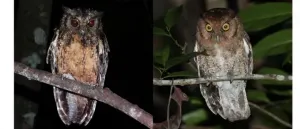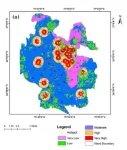Researchers discover new species of South American screech owls
Hidden biodiversity uncovered: researchers discover new species of South American screech owls
2021-03-26
(Press-News.org) New study led by the University of Helsinki supports the recognition of new species of South American owls, two of them, Xingu Screech Owl and Alagoas Screech Owl, described for the first time.
In early 2021 two new species of screech owls are being described in a single publication as new to science. A multinational team involving researchers from the University of Helsinki, Brazil, and the USA published a detailed study focusing on the morphological, vocal, and genetic variation in a group of screech owls from the Amazon and Atlantic Forest regions of South America, called the Black-capped / Tawny- bellied Screech Owl complex (Megascops atricapilla - M. watsonii). The term "complex" describes the overall uncertainty in the actual number of species in this group of screech owls, which has varied from one to three over the past decades.
"Not even professional ornithologists who have worked on owls for their entire lives would agree about the actual number of species found in this group, so a study like ours has been awaited for a really long time," says Alex Aleixo, head of the research team responsible for the study, and curator of birds at the Finnish Museum of Natural History in the University of Helsinki, Finland.
The new study published in the scientific journal Zootaxa demonstrated the discovery of six different genetic clusters in the Black-capped / Tawny-bellied Screech Owl complex that are also mutually distinguished by song - a strong indication that they are distinct species.
In contrast, as widely documented in owls, plumage color is variable in the complex, with a single genetic cluster for instance containing five distinct color forms ranging from cinnamon to red. Four out of these six genetic clusters had already been previously recognized as subspecies and given taxonomic names, and the new study support instead their treatment as distinct species. However, two of these clusters had never been recognized or described as unique, and thus had never been given a name. Therefore, the authors described these genetically and vocally diagnosable lineages as new species.
252 specimens, 83 tape-recordings, and 49 genetic samples analyzed
Researchers analyzed altogether, 252 specimens, 83 tape-recordings, and 49 genetic samples from across the range of the Black- capped / Tawny-bellied Screech Owl complex in South America. A significant part of specimens material were collected by the research team itself, mainly by nature tour leader and photographer Sidnei Dantas, who spent a good share of his time in graduate school searching for and tape-recording screech owls in South American rainforests. In addition, natural history collections and their materials collected over the centuries were essential to complete the study ?s unprecedented sampling.
One of these newly described species, the Xingu Screech Owl (Megascops stangiae), has its scientific name in honor of the late Sister Dorothy Mae Stang (1931?2005), an American-born Brazilian member of the Sisters of Notre Dame de Namur, who over 40 years introduced small farmers living in the Amazon to sustainability practices. The common name Xingu Screech Owl refers to the area where the new species is found, between the Tapajo?s and Xingu rivers, where Stang was a very active community leader until her killing.
The second new species described in the new study is the Alagoas Screech Owl (Megascops alagoensis), (Fig. 2), named after the state of Alagoas in Northeastern Brazil, where it was recorded for the first time in February 2001, and where most of the known population remains. This new species is known from only five isolated forest fragments in Alagoas and Pernambuco states.
Deforestation is a threat
Both new species of screech owls described by the new study, and a third one, formerly treated as a subspecies, but validated as a new species for the first time i.e., the Bele?m Screech Owl (Megascops ater),, are threatened by deforestation. The Xingu Screech Owl is endemic to the most severely burned area of the Amazon by the unprecedented 2019 fires and the Alagoas Screech Owl should be regarded as critically endangered given the extensive forest fragmentation in the very small area where it occurs. Finally, the Bele?m Screech Owl is endemic to the most deforested sector of the Amazon forest, with well over 80% of the original forest already cleared.
INFORMATION:
New research approaches
The recognition of these new species was only possible due to a combination of the application of modern technologies such as DNA sequencing of specimens and digital audio analytical techniques of recordings archived by natural history collections and citizen science databases. New approaches to studying museum specimens and increasingly accessible digital databases are completely transforming our comprehension of biodiversity, and are revealing the existence of long-overlooked but already threatened new species such as the screech owls discovered in the study published by Aleixo and colleagues.
[Attachments] See images for this press release:

ELSE PRESS RELEASES FROM THIS DATE:
2021-03-26
Every year, 10 million hectares of forest are lost. Among efforts to revive degraded or deforested land is the Bonn Challenge, with a global goal to bring into restoration 350 million hectares by 2030. Yet such efforts neglect the nuanced but critical factor of bringing genetic diversity into restoration efforts for long-term success, which urgently needs to be addressed.
Integrating genetic diversity involves planting tree species with different genetic makeups and varied species adapted to local environments. If species are the same, they will not be able to reproduce or grow new seedlings. Christopher Kettle, an ecologist and geneticist at the Alliance of Bioversity International and the ...
2021-03-26
As COVID-19 vaccines slowly roll out across the world, government officials in densely populated countries must still manage vulnerable communities at highest risk of an outbreak.
In a new study published in the Journal Risk Analysis, researchers in India propose a COVID Risk Assessment and Mapping (CRAM) framework that results in a zoned map that officials can use to place more targeted restrictions on high-risk communities. Successfully used by officials in Jaipur at the peak of the pandemic last spring, their framework could help other vulnerable countries avoid a shutdown of their regional economies.
Led by Shruti Kanga, associate professor in the Centre for Climate Change and Water Research at Suresh ...
2021-03-26
An estimated 6 million Americans may suffer from peanut allergies. Tiny amounts of peanut protein can lead to hives, itching, tingling in the mouth, shortness of breath or nausea within minutes.
For individuals with severe peanut allergies, food-induced anaphylaxis can occur. It's a life-threatening emergency that requires treatment with an injection of epinephrine and a trip to the emergency room. Food labels offer warnings such as "may contain peanuts" or "was processed in a facility that may process nuts."
The warnings allow individuals with severe reactions to steer clear, but for consumers who may be able to tolerate a minimal amount of peanut protein without major incident the labels aren't very useful, says Lynne Haber, PhD, ...
2021-03-26
Women who suffer from vision, hearing or dual sensory loss are more than twice as likely to report depression and anxiety as men who experience the same issues, according to a new study by Anglia Ruskin University (ARU).
The research, which has been published in the International Journal of Geriatric Psychiatry, looked at survey data from more than 23,000 adults, where participants had self-reported whether they had suffered depression or anxiety, and also whether they experienced vision, hearing, or dual (both vision and hearing) sensory impairment.
Across the whole sample, the prevalence of depression ...
2021-03-26
So far, there has been little research into supportive care needs in patients with newly diagnosed incurable cancer and as their disease progresses. That is why experts from the German Cancer Society's working group on palliative medicine, led by Professor Florian Lordick, Director of the University Cancer Center Leipzig (UCCL), surveyed 500 patients between the ages of 25 and 89. What made the project special was the fact that the patients were accompanied from the moment they were diagnosed and before receiving any treatment. Professor Lordick sums it up thus: "There is an urgent need for patients to have early access to supportive palliative ...
2021-03-26
Usually, the different areas in the cerebrum take on a very specific function. For example, they process our movements or things we see or hear, i.e. direct physical information. However, some areas of the brain come into play when dealing with more advanced mental tasks. They process incoming information that has already been pre-processed and is thus already at an abstract level.
It was already known that the inferior parietal lobe (IPL) is one of these regions in the human brain. Nevertheless, it was unclear how this area is able to process such very different functions. In a large study, scientists from the Max Planck Institute for Human Cognitive and Brain Sciences (MPI CBS) in Leipzig and McGill ...
2021-03-26
During a normal waking state, information is processed and shared by various parts within our brain to enable flexible responses to external stimuli. Researchers from the University of Turku, Finland, found that during hypnosis the brain shifted to a state where individual brain regions acted more independently of each other.
"In a normal waking state, different brain regions share information with each other, but during hypnosis this process is kind of fractured and the various brain regions are no longer similarly synchronised," describes researcher Henry Railo from the Department of Clinical Neurophysiology at the University of Turku.
The finding shows that the brain may function quite differently ...
2021-03-26
Scientists at the University of Bonn and the caesar research center have isolated a molecule that might open new avenues in the fight against SARS coronavirus 2. The active ingredient binds to the spike protein that the virus uses to dock to the cells it infects. This prevents them from entering the respective cell, at least in the case of model viruses. It appears to do this by using a different mechanism than previously known inhibitors. The researchers therefore suspect that it may also help against viral mutations. The study will be published ...
2021-03-26
Researchers have demonstrated that stretching shape-memory polymers embedded with clusters of gold nanoparticles alters their plasmon-coupling, giving rise to desirable optical properties. One potential application for the material is a sensor that relies on optical properties to track an object or environment's thermal history.
At issue is a stretchable polymer embedded with gold nanospheres. If the material is heated and stretched, followed by cooling to room temperature, the material will hold its stretched shape indefinitely. Once reheated to 120 degrees Celsius, the material returns to its original shape.
But what's really interesting is that the gold nanospheres are not perfectly dispersed in the polymer. ...
2021-03-26
A recent study published in JCI found that a neutrophil's endoplasmic reticulum, the organelle that normally makes proteins in the cell, becomes stressed in the autoimmune disorder lupus. This stress activates a molecule called IRE1α, which appears to play a critical role in lupus pathogenesis in mice.
A multidisciplinary research group at the University of Michigan, spanning microbiology, dermatology and rheumatology, discovered that IRE1α orchestrates the release of neutrophil extracellular traps, or NETs, from lupus neutrophils. NETs are sticky, spider web-like structures that cause inflammation when released at the wrong time or in the ...
LAST 30 PRESS RELEASES:
[Press-News.org] Researchers discover new species of South American screech owls
Hidden biodiversity uncovered: researchers discover new species of South American screech owls





